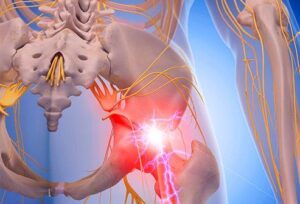Data have shown that the average adult in the United States sits for approximately 6.5 hours a day and that about a quarter of people sit for more than 8 hours each day. It is broadly recognized that sedentary behavior and lack of exercise can lead to obesity and related health problems. What is less well-known is that sitting for long periods significantly enhances people’s risk for developing low back pain. However, in some cases, sitting can be protective, reducing low back pain. Other behaviors in workspaces can also lead to painful condition. For instance, problematic wrist angles while typing can lead to carpal tunnel syndrome.
Understanding the best positioning techniques can help ensure that you do not develop painful conditions while in the workplace. Here are a few tips to keep in mind when you’re sitting at your desk for extended periods of time:
Maintain good posture with your spine flat.
It is important to keep your head upright and your spine straight. Research conducted on 20 healthy males examined the impact of spinal curvature while sitting on the men’s joints. The scientists compared slumped, flat, and flexed spinal curvatures and found that slumped and flexed spinal positions put more load on the joints than a flat position. They therefore concluded that keeping the back flat while sitting is a good way to reduce pressure on the back. Other researchers have seen similar results.
Back and neck pain can also lead to bad posture while people try to compensate for their pain. Slouching, though, can exacerbate pain problems and so should be avoided.
Shift your position from time to time.
A recent study on 23 people with low back pain and 23 healthy controls, all of whom worked in offices, investigated the relationship between specific sitting characteristics and low back pain. In addition to finding that spending more time in an asymmetrical position – or in other words, failing to maintain good posture – was associated with a greater likelihood of experiencing low back pain, the scientists also found that people who shifted their posture less frequently were more likely to have low back pain. Changing your position can help reduce the load on certain muscles and joints and give them time to rest, reducing your risk of developing pain.
Make sure your elbows are in contact with your rib cage.
People sometimes have a tendency during activities like typing to let their elbows float outward away from their bodies. However, data show that keeping the elbows close to the body is a better way to reduce the risk of low back pain. Those that do not keep their elbows close to their body have a higher likelihood of developing low back pain. If you keep in mind maintaining contact between your elbows and your rib cage, this approach should prevent you from letting your arms move to a position that could jeopardize your back.
Keep your pelvis higher than your knees.
A recent study has shown that a greater angle between the trunk and the thigh, also known as the hip joint angle, likely reduces load on the spine. Keeping your pelvis higher than your knees helps to keep this angle wider than if your knees are higher. Using a chair that is not too short for you can help ensure that your knees stay below your pelvis and help to protect your back.
Place your wrists below your elbows and above your knuckles.
Piano players who more regularly engage in extreme wrist extension or extreme elbow flexion are more likely to suffer upper extremity musculoskeletal symptoms. Keeping your arms and hands relatively still, preventing jerking movements or too much extension could help prevent pain throughout the arms, wrists, and hands. Indeed, bending the wrist such that the wrist goes higher than the elbows during things like typing can lead to wrist or elbow pain. In addition, if you allow your knuckles to rise higher than your wrists, your fingers are engaging in extreme
flexion. This type of flexion has been shown to affect the nerve at the crease of the wrist, which can lead to pain or discomfort.
Conclusion
It is difficult for many people to avoid many hours a day at their workspaces, and the longer work hours and increased time spent on computers has led people to develop painful conditions in their backs, legs, arms, and extremities. Luckily, research efforts have begun to focus on how best to prevent this type of pain from developing or how to minimize the pain that is already occurring. By following a few postural and movement guidelines, you should be able to avoid pain while continuing to be productive at work.













